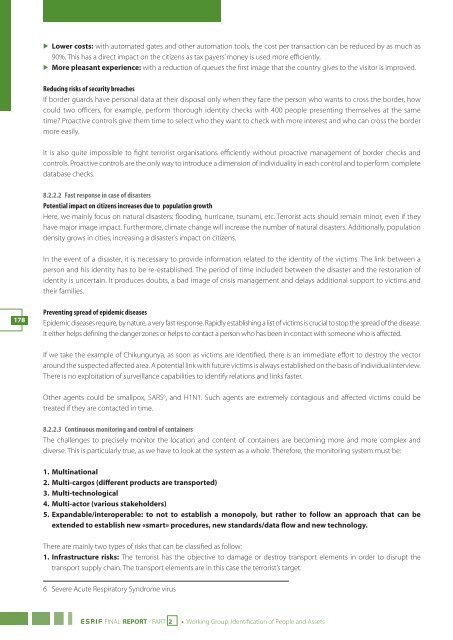I527-290 ESRIF Final Report (WEB).indd - European Commission
I527-290 ESRIF Final Report (WEB).indd - European Commission
I527-290 ESRIF Final Report (WEB).indd - European Commission
You also want an ePaper? Increase the reach of your titles
YUMPU automatically turns print PDFs into web optimized ePapers that Google loves.
178<br />
Lower costs: with automated gates and other automation tools, the cost per transaction can be reduced by as much as<br />
90%. This has a direct impact on the citizens as tax payers’ money is used more effi ciently.<br />
More pleasant experience: with a reduction of queues the fi rst image that the country gives to the visitor is improved.<br />
Reducing risks of security breaches<br />
If border guards have personal data at their disposal only when they face the person who wants to cross the border, how<br />
could two offi cers, for example, perform thorough identity checks with 400 people presenting themselves at the same<br />
time? Proactive controls give them time to select who they want to check with more interest and who can cross the border<br />
more easily.<br />
It is also quite impossible to fi ght terrorist organisations effi ciently without proactive management of border checks and<br />
controls. Proactive controls are the only way to introduce a dimension of individuality in each control and to perform complete<br />
database checks.<br />
8.2.2.2 Fast response in case of disasters<br />
Potential impact on citizens increases due to population growth<br />
Here, we mainly focus on natural disasters: fl ooding, hurricane, tsunami, etc. Terrorist acts should remain minor, even if they<br />
have major image impact. Furthermore, climate change will increase the number of natural disasters. Additionally, population<br />
density grows in cities, increasing a disaster’s impact on citizens.<br />
In the event of a disaster, it is necessary to provide information related to the identity of the victims. The link between a<br />
person and his identity has to be re-established. The period of time included between the disaster and the restoration of<br />
identity is uncertain. It produces doubts, a bad image of crisis management and delays additional support to victims and<br />
their families.<br />
Preventing spread of epidemic diseases<br />
Epidemic diseases require, by nature, a very fast response. Rapidly establishing a list of victims is crucial to stop the spread of the disease.<br />
It either helps defi ning the danger zones or helps to contact a person who has been in contact with someone who is aff ected.<br />
If we take the example of Chikungunya, as soon as victims are identifi ed, there is an immediate eff ort to destroy the vector<br />
around the suspected aff ected area. A potential link with future victims is always established on the basis of individual interview.<br />
There is no exploitation of surveillance capabilities to identify relations and links faster.<br />
Other agents could be smallpox, SARS 6 , and H1N1. Such agents are extremely contagious and aff ected victims could be<br />
treated if they are contacted in time.<br />
8.2.2.3 Continuous monitoring and control of containers<br />
The challenges to precisely monitor the location and content of containers are becoming more and more complex and<br />
diverse. This is particularly true, as we have to look at the system as a whole. Therefore, the monitoring system must be:<br />
1. Multinational<br />
2. Multi-cargos (diff erent products are transported)<br />
3. Multi-technological<br />
4. Multi-actor (various stakeholders)<br />
5. Expandable/interoperable: to not to establish a monopoly, but rather to follow an approach that can be<br />
extended to establish new «smart» procedures, new standards/data fl ow and new technology.<br />
There are mainly two types of risks that can be classifi ed as follow:<br />
1. Infrastructure risks: The terrorist has the objective to damage or destroy transport elements in order to disrupt the<br />
transport supply chain. The transport elements are in this case the terrorist’s target.<br />
6 Severe Acute Respiratory Syndrome virus<br />
<strong>ESRIF</strong> FINAL REPORT - PART 2 • Working Group: Identifi cation of People and Assets

















